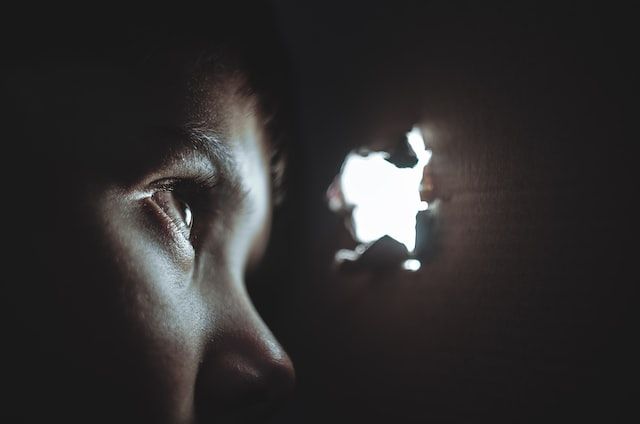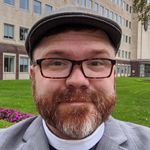Always Looking But Do We Really See?

As we move closer and closer to Easter, Lent continues doing its work of preparing us for the Paschal mystery. The Great Vigil of Easter is the liturgy from which all others take their shape. Our offices of prayer and our sacramental rites–even this one–are reflections of portions of that night’s great offering of worship.
In our preparation for that great night, we pray for many things, not least of which is the preparation of those who will be baptized and confirmed. Among the hopes for those preparing for those sacraments is the revelation of God’s truth. Some understanding of who God is and what sort of divine relationship the catechumens are preparing to join. We pray for their enlightenment.
Today’s readings are full of images, illustrations, and stories about what enlightenment means. What it is to see a glimpse of the whole truth of God.
In the first reading, we hear about what it is to trust God to reveal what is needed. God reveals to Samuel that there is a king to be found among Jesse’s sons. Of course, when Samuel goes to locate the man and all of Jesse’s sons are shown to him, none seems to bear the countenance of God’s chosen king. Rather than question whether God has sent him to the right place or what God needs–how often do we suppose we know better than God what is needed?–Samuel questions Jesse and suggests he surely has another son. Of course, he does have, but nobody would have ever thought little David the shepherd was the one Samuel was sent to find. God, so very often, chooses those that we would rather overlook. Those that we would rather not see.
Sometimes we see what we expect to see, especially when we are looking at words or objects from contexts that are unfamiliar to us. In his letter to the Christians of Ephesus, Paul makes much of what it is to be light and dark. To our twenty-first century eyes, it might seem a reasonable leap to think that Paul is speaking of the colour of people’s skin. This passage has certainly been used by racists as support for their various agendas in history.
It is important to know that, in the first-century world of the Mediterranean, skin colour was not as important as we believe it to be today. Travel, commerce, and relationships were commonplace between southern Europe, southwestern Asia, northern Africa, and farther afield. Variations in skin tone were much less important than the languages one spoke, the clothing one wore, the religion one practiced, and the nation in which one claimed membership.
Paul is speaking about being light or dark as an emphatic way of speaking about seeking revelation and seeing the truth of God revealed in Christ. Light is a useful thing when we are looking for something. For all of our gifts, humans are not gifted with keen sight in the dark. Paul is making the point that, when we are seeking God, we should go so far as to not only make use of light in our search, but to actually be light. To be so dedicated to seeking and living in our new life in Christ that we reflect the Light of the World to the people and places around us.
In today’s gospel passage, we hear much about seeing. I believe there is even more about sight and the truth to be learned from this passage if we look beyond the surface story of a miracle. The very first question posed to Jesus, about whose sin is responsible for the man’s blindness, is a question that Jesus categorically rejects. The man is not blind because of anyone’s sin; rather, he is blind that God’s glory might be shown forth in him. Perhaps, put another way: This man is not blind because of anything that he, his parents, or anyone else did; this man is blind so that, through his blindness, you all might see God’s truth.
There is a gesture in the healing miracle to the themes of baptism which we are approaching. Jesus uses his own spittle to make the mud that will give the man sight. It is only when the man’s body, and by extension his life, are materially joined to that of Jesus that he sees and, through his seeing, the others begin to question whether they are truly seeing. This idea of holiness, miracles, and divine power being connected, at least in part, through physical, material means is deeply important to the Early Church and is seen even today in conversations about saints, martyrs, relics, and material remnants of holy events.
Through the argument about the legality of healing on the sabbath, Jesus challenges the commonly-held ideas about when and how God might work. Of course, God can do as and when God wishes. While the questions are framed about whether or not Jesus was righteous in working on the sabbath, what is really being questioned are the crowd’s ideas about God’s presence in their lives.
If we divert for a moment to Mark’s gospel, we remember Jesus saying “The sabbath was made for humankind, not humankind for the sabbath.” (Mark 2.27) If we extend this thought, we can reason that God’s laws were made for us, as well, and not us for the laws. Nor were God’s laws made for God. At each step of the argument–the disbelief of the miracle, the question of its legality, the identity and nature of Jesus– the carefully constructed and dearly held ideas of the newly-sighted man’s community are being called into question. And not questioned in the abstract, but in a real and material way with hard evidence of the unexpected and miraculous. This is enough to shake up even the most convinced and stalwart Pharisee’s understanding of how things are meant to work.
The gospel passage ends with the man’s profession of faith, having been driven out by his community. When they see this last interaction between him and Jesus, some of the Pharisees reveal that they now understand what God is showing them. They ask Jesus whether or not they are, in fact, the blind ones. Jesus replies saying that, if they were blind, they would not have sin but they claim to see and sin remains. Put another way, Jesus is saying that if they were like this man, willing to see what God had actually put before them, rather than what they were expecting and looking for, they would also see the truth.
This practice of always looking for what God is doing in our midst and what God has put before us is one that we need to be reminded of again and again. We, just like the skeptics in today’s gospel and those early Christians in Ephesus, are so prone to deciding what we think God ought to do and then watching for evidence that we were right. Of course, our job is to submit our own wills to that of God and to take up God’s invitation to cooperate in what God is doing, not to dictate the terms of God’s engagement with us.
This teaching of Jesus is a critical lesson for those preparing for the sacraments of initiation and a reminder for each of us. We must always be asking ourselves, “Where was God in that moment? In that interaction? In that relationship? In that event?” God does not demand that we go searching. There is no divine game of hide and seek. God is always with us and asks only that we look, that we seek, that we follow God to the places where God wills to be found. Whether they be in the font of new life, in the eyes of a blind man, or in the most unlikely of people.
Photo by Dmitry Ratushny on Unsplash





